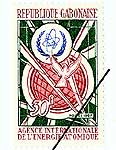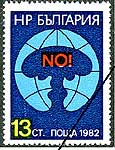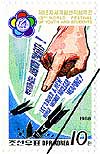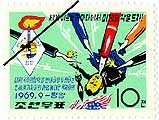World peace postage stamps from the Pika Collection
"Ambassadors" that connect us across national boundaries

Please click to view enlarged image.
Have you ever been attracted to a postage stamp on a letter you've received? Stamps are very small in size but they can cross national boundaries like "ambassadors" and connect the hearts and minds of different people. Their colorful designs may convey all sorts of different messages.
We met Mr. Seseragi (pen name), who runs the "Pika Research Center" which collects and researches postage stamps from around the world related to the theme of world peace. He showed us the center's valuable collections. Mr. Seseragi has spent more than fifty years researching the damage caused by the atomic bomb, especially focusing on the Allied Occupation period (1945-1952).
The junior writers looked at rare stamps such as North Korea's stamp calling for the abolition of nuclear weapons and a stamp from the former Czechoslovakia showing the mushroom cloud, while Mr. Seseragi explained them to us.

Picture : Mr. Seseragi (front right) shows stamps to junior writers. (Photo by Seira Furukawa, 14)
Click to view workshop with Mr. Seseragi
500,000-600,000 kinds of postage stamps have been issued worldwide
The world's first postage stamp was issued in the United Kingdom in 1840. According to "Philatelic Museum," which is located in Tokyo, 500,000-600,000 kinds of stamps have been issued worldwide so far, while more than 10,000 kinds of stamps are issued every year.
Before the postage stamp system was introduced in Great Britain, postage was paid on delivery, by the receiver. Mr. Seseragi explained that the significance of postage stamps was that it was now the sender who paid for postage so senders no longer hesitated to send letters and the result was an increase in the exchange of mail. The first Japanese postage stamp was made in 1871 during the Meiji Era.
As the use of postage stamps spread, many different stamp designs were issued.
Among the stamps from various countries that Mr. Seseragi showed us, there was a stamp with a picture of a crossed-out mushroom cloud and another stamp showed a missile being squashed. Mr. Seseragi believes that the miniature designs on the stamps enabled people to express their opinion: "They show us human wisdom." We felt that stamps like these can deliver a powerful message to the receiver that nuclear weapons are bad.
Mr. Seseragi also showed us some designs that featured doves.
A stamp issued in East Germany in 1950 shows a dove in the foreground, with a mushroom cloud and a bomb behind it being blocked by a human hand. Other examples of peace stamps with a dove in the design can be found in stamps issued in India and Uruguay in Central America.
It seems that the Old Testament had a big influence on the association of the images of "doves" and "peace." The Book of Genesis tells how, after the Great Flood, Noah released a dove from the ark and it returned with an olive leaf. The dove showed that there was land, in other words, the dove brought a blessing to humanity so it became a symbol of the bringing of peace. (Ayano Koide, 14)
Ghana, 1962 The terror of atomic bombs is expressed in the color 
This stamp was issued in commemoration of a conference at the Accra Assembly in Ghana, West Africa, in 1962 which called for worldwide arms reduction. It is one of a set of three stamps. On this stamp, a mushroom cloud forms a skull with a sinister dark red background, which makes us think about the terror of atomic bombs.
I have heard that the Mayor of Hiroshima at the time, Shinzo Hamai, attended the Assembly and warned that "nuclear war would be nothing less than the suicide of the human race." (Aya Tsuchie, 16 )
Gabon, 1967 Appeal for the peaceful use of atomic power 
A stamp of Gabon in Central Africa shows the International Atomic Energy Agency (IAEA), which was established with the aim of promoting the peaceful use of atomic power. The stamp was issued in 1967. It shows a dove taking off and the mark of the IAEA on the globe.
At first glance, the IAEA has little to do with doves, but I feel that it was used to raise awareness of the importance of the peaceful use of atomic power by combining atomic power with the symbol of peace. (Aya Tsuchie, 16)
Former Czechoslovakia, 1969 Vivid depiction of people suffering
In 1969, the former Eastern European state of Czechoslovakia issued a stamp to commemorate the 20th anniversary of the peace movement. It depicts the mushroom cloud and people injured by war.
The stamp offers a graphic depiction of bodies and debris, with people and horses writhing on the bloodstained earth. A mushroom cloud rises behind them. Mr. Seseragi points out that its message is as strong as Picasso's "Guernika". (Aya Tsuchie, 16)
Bulgaria, 1982 A vigorous "No" to the mushroom cloud 
In 1982, the Eastern European state of Bulgaria issued a stamp that made use of a mushroom cloud design as part of an anti-nuclear campaign. A red "NO!" on the dark blue part of a mushroom cloud clearly expresses the purpose of opposing nuclear weapons.
Mr. Seseragi showed us other anti-nuclear stamps with a mushroom cloud and nuclear weapons which have been crossed out, but in my opinion, the word "NO" feels stronger. (Daishi Kobayashi, 15)
Cuba 1979 Fist squashing a bomb 
In 1979, the Central American state of Cuba issued a stamp marking the 30th anniversary of the World Peace Conference. Five different colored fists, symbolizing various ethnicities, are raised high. According to Mr. Seseragi, it appears that a bomb is being crushed and a dove, a symbol of peace, is being released into the sky.
I think the fists are effectively designed in this stamp to show a strong will to work together to bring about a peaceful world. (Daishi Kobayashi, 15)
North Korea 1988 (left) and 1969 (right)
There was a time they also appealed for nuclear abolition


In 1988, a commemorative stamp of the 13th World Festival of Youth and Students was issued in North Korea. It shows an atomic bomb with a broken letter "A" and it reads, English, "Let's build a new world without nuclear weapons." The stamp is very interesting because it was issued in a country which conducted a nuclear weapons test two years ago.
Another stamp, issued in 1969 to commemorate the "International Conference of Journalists Against American Imperialism," shows five pens attacking the American President of that time, Richard Nixon. A tattered Star Spangled Banner is beneath, as Mr. Seseragi told us. (Daishi Kobayashi, 15)
Former North Vietnam, 1969 Celebrating China's successful H-bomb test 
This is a stamp that was issued in the former North Vietnam in 1967 to celebrate China's first successful hydrogen bomb test. A dove is flying with a festival lantern in its beak. There is a letter "H" on the lantern, which stands for "hydrogen bomb," and the date of the test.
Mr. Seseragi explained the social background at that time and that China supported North Vietnam during Vietnam War. However, it is incredible to me that they celebrated a nuclear test. (Daishi Kobayashi, 15)
Paintings by Picasso also become stamps, with doves as a symbol of peace


Pablo Picasso (1881-1973) was famous for paintings that appealed for peace, such as "Guernika," and some of his paintings were used as designs for stamps. Mr. Seseragi says because Picasso painted a dove on a poster for the Paris Peace Conference in 1949, the idea that the dove was a symbol of peace spread even further around the world.
China issued a series of stamps calling for the preservation of peace in 1950 with a painting of a standing dove and an olive leaf below (top left). Mr. Seseragi told us that Picasso joined the Communist Party in 1944 so China made use of many of his paintings.
Both the 1951 and 1953 issues of stamps in the same series show doves flapping their wings. The stamps issued in 1952 commemorate the Asian Pacific Peace Conference. They have two designs: in one, a dove is flying in the sky; in the other, a dove is flying around the globe.
Dove designs aside, "Guernika" (1937) is also featured in a stamp (left). It is a famous painting, or mural, which Picasso was inspired to paint in response to the shock of the massacre of civilians in a German air attack. The stamp was issued in 1981 in his mother country, Spain. (Mako Sakamoto, 11)
Note: The slash mark on every stamp is in accordance with Japanese regulation to prevent duplication.

- Pika Research Center (located in Takehara city)
Since 1952, the Pika Research Center has conducted research on atomic bomb-related literature published during the Allied occupation, building up a collection of books, magazines, pamphlets, and other items. Some of the important documents are sometimes used as reference material by the National Diet Library and other institutions. In 1973, the Center handed over 3,159 documents to the city of Hiroshima. The Center has published the results of its research in a catalog of documents related to the atomic bombing (currently in four volumes).
"Ambassadors" that connect us across national boundaries

|
Please click to view enlarged image. |
Have you ever been attracted to a postage stamp on a letter you've received? Stamps are very small in size but they can cross national boundaries like "ambassadors" and connect the hearts and minds of different people. Their colorful designs may convey all sorts of different messages.
We met Mr. Seseragi (pen name), who runs the "Pika Research Center" which collects and researches postage stamps from around the world related to the theme of world peace. He showed us the center's valuable collections. Mr. Seseragi has spent more than fifty years researching the damage caused by the atomic bomb, especially focusing on the Allied Occupation period (1945-1952).
The junior writers looked at rare stamps such as North Korea's stamp calling for the abolition of nuclear weapons and a stamp from the former Czechoslovakia showing the mushroom cloud, while Mr. Seseragi explained them to us.
| ||
|
500,000-600,000 kinds of postage stamps have been issued worldwide
The world's first postage stamp was issued in the United Kingdom in 1840. According to "Philatelic Museum," which is located in Tokyo, 500,000-600,000 kinds of stamps have been issued worldwide so far, while more than 10,000 kinds of stamps are issued every year.
Before the postage stamp system was introduced in Great Britain, postage was paid on delivery, by the receiver. Mr. Seseragi explained that the significance of postage stamps was that it was now the sender who paid for postage so senders no longer hesitated to send letters and the result was an increase in the exchange of mail. The first Japanese postage stamp was made in 1871 during the Meiji Era.
As the use of postage stamps spread, many different stamp designs were issued.
Among the stamps from various countries that Mr. Seseragi showed us, there was a stamp with a picture of a crossed-out mushroom cloud and another stamp showed a missile being squashed. Mr. Seseragi believes that the miniature designs on the stamps enabled people to express their opinion: "They show us human wisdom." We felt that stamps like these can deliver a powerful message to the receiver that nuclear weapons are bad.
Mr. Seseragi also showed us some designs that featured doves.
A stamp issued in East Germany in 1950 shows a dove in the foreground, with a mushroom cloud and a bomb behind it being blocked by a human hand. Other examples of peace stamps with a dove in the design can be found in stamps issued in India and Uruguay in Central America.
It seems that the Old Testament had a big influence on the association of the images of "doves" and "peace." The Book of Genesis tells how, after the Great Flood, Noah released a dove from the ark and it returned with an olive leaf. The dove showed that there was land, in other words, the dove brought a blessing to humanity so it became a symbol of the bringing of peace. (Ayano Koide, 14)
Ghana, 1962 The terror of atomic bombs is expressed in the color | |
 |
This stamp was issued in commemoration of a conference at the Accra Assembly in Ghana, West Africa, in 1962 which called for worldwide arms reduction. It is one of a set of three stamps. On this stamp, a mushroom cloud forms a skull with a sinister dark red background, which makes us think about the terror of atomic bombs. I have heard that the Mayor of Hiroshima at the time, Shinzo Hamai, attended the Assembly and warned that "nuclear war would be nothing less than the suicide of the human race." (Aya Tsuchie, 16 ) |
Gabon, 1967 Appeal for the peaceful use of atomic power | |
 |
A stamp of Gabon in Central Africa shows the International Atomic Energy Agency (IAEA), which was established with the aim of promoting the peaceful use of atomic power. The stamp was issued in 1967. It shows a dove taking off and the mark of the IAEA on the globe. At first glance, the IAEA has little to do with doves, but I feel that it was used to raise awareness of the importance of the peaceful use of atomic power by combining atomic power with the symbol of peace. (Aya Tsuchie, 16) |
Former Czechoslovakia, 1969 Vivid depiction of people suffering | |
 |
In 1969, the former Eastern European state of Czechoslovakia issued a stamp to commemorate the 20th anniversary of the peace movement. It depicts the mushroom cloud and people injured by war. The stamp offers a graphic depiction of bodies and debris, with people and horses writhing on the bloodstained earth. A mushroom cloud rises behind them. Mr. Seseragi points out that its message is as strong as Picasso's "Guernika". (Aya Tsuchie, 16) |
Bulgaria, 1982 A vigorous "No" to the mushroom cloud | |
 |
In 1982, the Eastern European state of Bulgaria issued a stamp that made use of a mushroom cloud design as part of an anti-nuclear campaign. A red "NO!" on the dark blue part of a mushroom cloud clearly expresses the purpose of opposing nuclear weapons. Mr. Seseragi showed us other anti-nuclear stamps with a mushroom cloud and nuclear weapons which have been crossed out, but in my opinion, the word "NO" feels stronger. (Daishi Kobayashi, 15) |
Cuba 1979 Fist squashing a bomb | |
 |
In 1979, the Central American state of Cuba issued a stamp marking the 30th anniversary of the World Peace Conference. Five different colored fists, symbolizing various ethnicities, are raised high. According to Mr. Seseragi, it appears that a bomb is being crushed and a dove, a symbol of peace, is being released into the sky. I think the fists are effectively designed in this stamp to show a strong will to work together to bring about a peaceful world. (Daishi Kobayashi, 15) |
North Korea 1988 (left) and 1969 (right) There was a time they also appealed for nuclear abolition | |
  |
In 1988, a commemorative stamp of the 13th World Festival of Youth and Students was issued in North Korea. It shows an atomic bomb with a broken letter "A" and it reads, English, "Let's build a new world without nuclear weapons." The stamp is very interesting because it was issued in a country which conducted a nuclear weapons test two years ago. Another stamp, issued in 1969 to commemorate the "International Conference of Journalists Against American Imperialism," shows five pens attacking the American President of that time, Richard Nixon. A tattered Star Spangled Banner is beneath, as Mr. Seseragi told us. (Daishi Kobayashi, 15) |
Former North Vietnam, 1969 Celebrating China's successful H-bomb test | |
 |
This is a stamp that was issued in the former North Vietnam in 1967 to celebrate China's first successful hydrogen bomb test. A dove is flying with a festival lantern in its beak. There is a letter "H" on the lantern, which stands for "hydrogen bomb," and the date of the test. Mr. Seseragi explained the social background at that time and that China supported North Vietnam during Vietnam War. However, it is incredible to me that they celebrated a nuclear test. (Daishi Kobayashi, 15) |
Paintings by Picasso also become stamps, with doves as a symbol of peace | |
  |
Pablo Picasso (1881-1973) was famous for paintings that appealed for peace, such as "Guernika," and some of his paintings were used as designs for stamps. Mr. Seseragi says because Picasso painted a dove on a poster for the Paris Peace Conference in 1949, the idea that the dove was a symbol of peace spread even further around the world. China issued a series of stamps calling for the preservation of peace in 1950 with a painting of a standing dove and an olive leaf below (top left). Mr. Seseragi told us that Picasso joined the Communist Party in 1944 so China made use of many of his paintings. Both the 1951 and 1953 issues of stamps in the same series show doves flapping their wings. The stamps issued in 1952 commemorate the Asian Pacific Peace Conference. They have two designs: in one, a dove is flying in the sky; in the other, a dove is flying around the globe. Dove designs aside, "Guernika" (1937) is also featured in a stamp (left). It is a famous painting, or mural, which Picasso was inspired to paint in response to the shock of the massacre of civilians in a German air attack. The stamp was issued in 1981 in his mother country, Spain. (Mako Sakamoto, 11) |
Note: The slash mark on every stamp is in accordance with Japanese regulation to prevent duplication.
- Pika Research Center (located in Takehara city)
Since 1952, the Pika Research Center has conducted research on atomic bomb-related literature published during the Allied occupation, building up a collection of books, magazines, pamphlets, and other items. Some of the important documents are sometimes used as reference material by the National Diet Library and other institutions. In 1973, the Center handed over 3,159 documents to the city of Hiroshima. The Center has published the results of its research in a catalog of documents related to the atomic bombing (currently in four volumes).